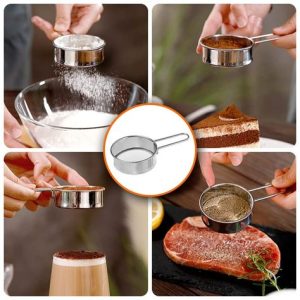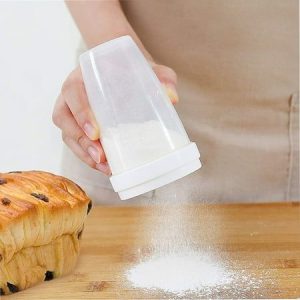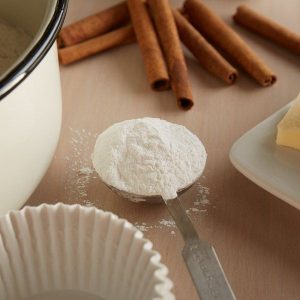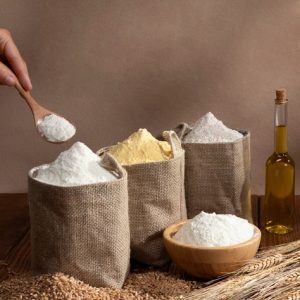Physical Address
304 North Cardinal St.
Dorchester Center, MA 02124
Physical Address
304 North Cardinal St.
Dorchester Center, MA 02124

Baking powder and flour are two essential ingredients in many baked goods. They play very different roles, though. In this article, we’ll explore the key differences between baking powder and flour, and answer the question: can you substitute baking powder for flour?
Baking powder is a leavening agent. Leavening agents create gas bubbles in batter or dough, which causes baked goods to rise. Baking powder typically contains a combination of baking soda, an acidic ingredient (like cream of tartar), and a starch (like cornstarch).
Here’s how baking powder works:
The acidic ingredient reacts with the baking soda, releasing carbon dioxide gas.
The gas bubbles get trapped in the dough or batter.
As the baked good cooks, the trapped gas bubbles expand, causing the dough or batter to rise.

Flour is a dry ingredient made by grinding grains like wheat, rye, or oats. It provides structure and body to baked goods. Here are the two main types of flour used in baking:
All-purpose flour: This is the most common type of flour. It has a moderate amount of protein, making it suitable for a variety of baked goods like cookies, cakes, and muffins.
Bread flour: Bread flour has a higher protein content than all-purpose flour. This higher protein content leads to the development of gluten, which creates a chewier texture, ideal for breads.
No, you cannot substitute baking powder for flour. Baking powder and flour play entirely different roles in baking.
A baked good made without flour would be crumbly and wouldn’t hold its shape.
Using too much baking powder can have negative consequences for your baked goods:
Bitter taste: Excess baking powder can leave a bitter taste.
Crumbly texture: Too much gas can cause the structure of the baked good to weaken, resulting in a crumbly texture.
Cakes that fall: In cakes, too much baking powder can cause the cake to rise too quickly and then collapse.

If you forget to add baking powder, your baked goods will be dense and flat. They won’t rise properly because there won’t be any gas bubbles to create lift.
In a pinch, there are a few substitutes you can use for baking powder, but none are perfect. Here are a couple options:
Baking soda with an acidic ingredient: If your recipe calls for baking powder, you can sometimes substitute with baking soda and an acidic ingredient like buttermilk, lemon juice, or cream of tartar. However, the proportions won’t be exactly the same, and the results may vary.
Self-rising flour: Self-rising flour already contains baking powder. You can use self-rising flour in place of all-purpose flour, but you’ll need to adjust the recipe to account for the added leavening agent.
Important note: Always double-check the recipe and ingredient amounts before attempting any substitutions.
Baking powder and flour are both essential ingredients for baking success. They work together to create delicious and beautiful baked goods. Remember, baking powder creates lift, and flour provides structure. Don’t try to swap one for the other!
For perfect baking, focus on using high-quality ingredients and following your recipes carefully. Happy baking!

Baking can be a fun and rewarding activity! It allows you to get creative in the kitchen and enjoy delicious homemade treats. But understanding the role of different ingredients is key to success. In this article, we explored the key differences between baking powder and flour. We also learned that you cannot substitute baking powder for flour because they have different functions.
Let’s delve deeper into the world of baking substitutions!
Sometimes, you might find yourself missing an ingredient for a recipe. Here are some tips for finding suitable substitutes:

Baking is more than just mixing ingredients together. It’s a delicate balance of science and chemistry. Different ingredients play specific roles and work together to create the final product. Here’s why substitutions can be tricky:
Different Properties: Ingredients have different properties that affect the final baked good. For example, some flours are high in protein, which leads to chewier textures, while others are lower in protein for softer baked goods.
Chemical Reactions: Baking involves chemical reactions between ingredients. Substituting an ingredient can alter these reactions and lead to unintended results.
Following recipes closely, especially when you’re new to baking, is a good way to ensure success. Recipes are formulated to create specific results, and using the correct ingredients is important.
However, as you gain experience and knowledge about different ingredients, you can experiment with substitutions more confidently.

We already learned that baking powder and flour play very different roles. Baking powder creates lift, and flour provides structure. So, using baking powder instead of flour wouldn’t work in a recipe.
Let’s explore some tips for successful baking!
Gather your ingredients: Make sure you have all the ingredients called for in your recipe before you start baking. This will help avoid any last-minute substitutions that might affect the outcome.
High-quality ingredients: Using high-quality ingredients can make a big difference in the taste and texture of your baked goods.
Follow the recipe: Baking often relies on precise measurements and techniques. Following your recipe closely will increase your chances of success.
Prepping is key: Preheat your oven and prepare your pans according to the recipe instructions. This ensures everything is ready when your batter or dough is mixed.
Don’t overmix! Overmixing batters and doughs can lead to tough and dense baked goods. Mix until just combined according to the recipe’s instructions.
Let your baked goods cool completely: This is especially important for things like cookies and cakes. Resist the urge to dig in right away!
By following these tips and using the right ingredients for the job, you’ll be well on your way to baking success! Now you’re ready to grab your favorite recipe and create something delicious.
Baking is a fun and rewarding skill to learn. By understanding the roles of different ingredients and approaching substitutions with caution, you can create delicious baked goods in your kitchen. So, preheat your oven, grab your favorite recipe, and get ready to bake!